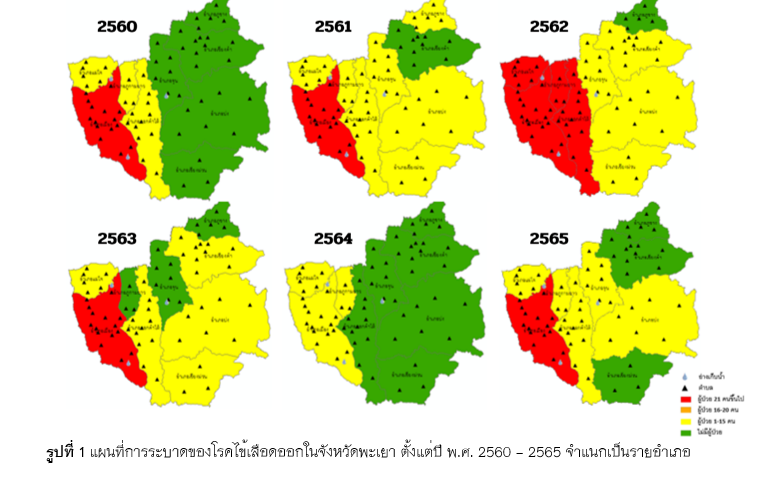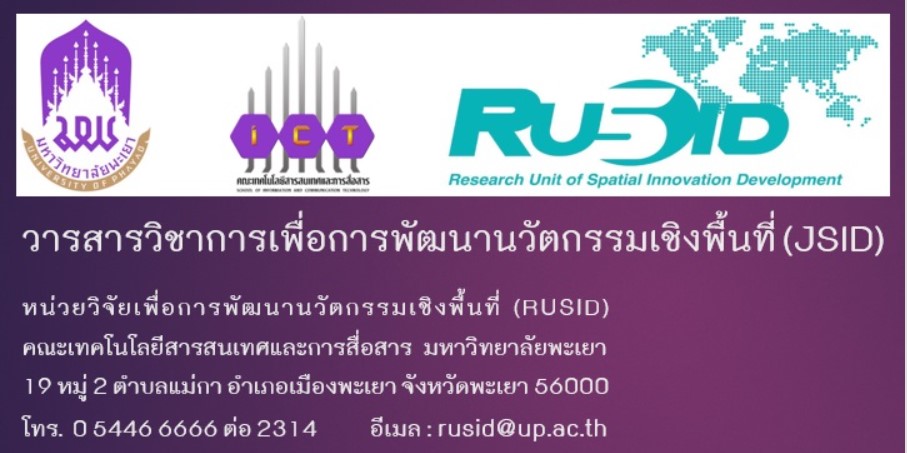แนวทางการเรียนรู้ของเครื่องเพื่อการทำนายไข้เลือดออก: กรณีศึกษาจังหวัดพะเยา
คำสำคัญ:
ไข้เลือดออก, เทคนิคการเรียนรู้ของเครื่อง, แบบจำลองการพยากรณ์, การถดถอยเชิงเส้น, การเรียนรู้เชิงลึกบทคัดย่อ
โรคไข้เลือดออกเป็นโรคร้ายแรงที่เกิดจากเชื้อไวรัสโดยมียุงลายเป็นพาหะ เป็นปัญหาสำคัญของกระทรวงสาธารณสุขในหลายประเทศทั่วโลก งานวิจัยนี้จึงมีวัตถุประสงค์เพื่อศึกษาปัจจัยที่มีผลต่อการระบาดของโรคไข้เลือดออกและสร้างแบบจำลองในการพยากรณ์โรคไข้เลือดออกที่มีประสิทธิภาพ ด้วยเทคนิคการเรียนรู้ของเครื่อง โดยใช้ข้อมูลจากสถานีอุตุนิยมวิทยาพะเยา ได้แก่ สภาพภูมิอากาศ อุณหภูมิความชื้นสัมพัทธ์ ปริมาณน้ำฝน จำนวนวันที่ฝนตก และข้อมูลจำนวนประชากรในพื้นที่จังหวัดพะเยา จากฐานข้อมูล สำนักงานสาธารณสุขจังหวัดพะเยารวมถึงจำนวนผู้ป่วยโรคไข้เลือดออก กลุ่มเพศ และกลุ่มอายุ จากโรงพยาบาลพะเยา ตั้งแต่ ปี พ.ศ. 2560 - 2565 โดยนำมาวิเคราะห์และสร้างแบบจำลองด้วยเทคนิคการเรียนรู้ของเครื่อง 10 วิธี โดยประเภท Regression ได้แก่ Support Vector Machines และ Linear Regression ส่วนประเภท Classification ได้แก่ Artificial Neural Network, Decision Tree, Naïve Bayes, K-Nearest Neighbors, Deep learning, Random Trees, Gradient Boosting และ Logistic Regression และทำการวัดประสิทธิภาพแบบจำลองด้วยวิธีการ 5-Fold Cross Validation
ข้อมูลทั้งหมดถูกสร้างเป็น dataset แบบรายเดือนและรายสัปดาห์ ซึ่งจากผลการวัดประสิทธิภาพของแบบจำลองประเภท Regression พบว่า Linear Regression ให้ประสิทธิภาพดีที่สุด ที่ RMSE 1.190 และในประเภท Classification พบว่า Deep learning เป็นแบบจำลองที่มีประสิทธิภาพที่สุด ที่ให้ประสิทธิภาพดีที่สุด ที่ Accuracy 99.84% โดยพิจารณาจากค่าความแม่นยำและค่าประสิทธิภาพโดยรวมสูงที่สุด ผลจากการทำวิจัยในครั้งนี้สามารถเป็นแนวทางในการประยุกต์ นำไปใช้ประโยชน์ได้อย่างแพร่หลายโดยเฉพาะหน่วยงานต่าง ๆ ที่เกี่ยวข้องในการวางแผนการเฝ้าระวัง การหาพื้นที่เสี่ยงการระบาด การป้องกันและการควบคุมโรคไข้เลือดออกได้อย่างมีประสิทธิภาพ
เอกสารอ้างอิง
กรมควบคุมโรค. (2560). ความรู้ทั่วไปโรคไข้เลือดออก. นนทบุรี: กระทรวงสาธารณสุข.
กลุ่มโรคติดต่อระหว่างประเทศ กองโรคติดต่อทั่วไป กรมควบคุมโรค. (2563). ไข้เลือดออก (Dengue Fever และ Dengue Hemorrhagic Fever) (ICD 10 A90, A91). พะเยา: กรมควบคุมโรค.
กาญจนา ยังขาว และ กัญญรัตน์ สระแก้ว. (2558). การพยากรณ์โรคไข้เลือดออกโดยใช้ข้อมูล 5 มิติเขตสุขภาพที่ 9. วารสารควบคุมโรค, 41(3), 208 - 218.
กอบเกียรติ สระอุบล. (2563). เรียนรู้ Data Science และ AI: Machine Learning ด้วย Python. กรุงเทพฯ: หสม มีเดีย เนทเวิร์ค.
จิรโรจน์ ตอสะสุกุล. (2564). แบบจำลองการพยากรณ์ของการระบาดโรคไข้เลือดออกโดยใช้เทคนิคการทำเหมือง ข้อมูล. วารสารวิชาการซายน์เทค มรภ.ภูเก็ต, 5(2), 51 - 60.
ชาญชัยณรงค์ ทรงคาศรี. (2555). รูปแบบการพยากรณ์โรคไข้เลือดออกในพื้นที่สำนักงานป้องกันควบคุมโรคที่ 6จังหวัดขอนแก่น พ.ศ. 2555. วารสารวิชาการสำนักป้องกันควบคุมโรคที่ 7 ขอนแก่น, 20(1), 65 - 81.
สำนักงานสาธารณสุขจังหวัดพะเยา. (2566). บทสรุปผู้บริหาร สถานการณ์โรคไข้เลือดออก จังหวัดพะเยา (ฉบับที่ 1 ปี 2566). พะเยา.
สำนักโรคติดต่อนำโดยแมลง สำนักระบาดวิทยา. (2560). รายงานพยากรณ์โรค “ไข้เลือดออก” ปี 2560 (ฉบับที่ 1 ปี 2560). พะเยา.
สายชล สินสมบูรณ์ทอง. (2560). การทำเหมืองข้อมูล เล่ม 1: การค้นหาความรู้จากข้อมูล. กรุงเทพฯ: บริษัทจามจุรีโปรดักส์ จำกัด.
สุรศักดิ์ สุขสาย. (2550). การพยากรณ์พื้นที่เสี่ยงต่อการเกิดโรคไข้เลือดออกเพื่อการวางแผนเฝ้าระวังและป้องกันในจังหวัดอุบลราชธานี. วารสารวิจัย มข. (บศ.), 7(2), 83-96. สืบค้นจาก https://aigencorp.com/what-is-machine-learning-technology.
Chaw, J. K., Chaw, S. H., Quah, C. H., Sahrani, S., Ang, M. C., Zhao, Y., & Ting, T. T. (2023). A predictive analytics model using machine learning algorithms to estimate the risk of shock development among dengue patients, Healthcare Analytics, 5, 2-7.
Majeed, M. A., Shafri, H. Z. M., Zulkafli, Z., & Wayayok, A. (2023). A Deep Learning Approach for Dengue Fever Prediction in Malaysia Using LSTM with Spatial Attention. International Journal of Environmental Research and Public Health, 20(5), 2-4. Form: https://www.ncbi.nlm.nih.gov/pmc/articles/PMC10002017/.
Mehta, A. M., & Patel, K. S. (2023), LSTM-based Forecasting of Dengue Cases in Gujarat: A Machine Learning Approach, Indian Journal of Science and Technology, 17(7), 635 - 642. Form: https://indjst.org/articles/lstm-based-forecasting-of-dengue-cases-in-gujarat-a-machine-learning-approach.
Mierswa, I., & Klinkenberg, R. (2018). RapidMiner Studio (9.1) [Data science, machine learning, predictive analytics]. Form: https://rapidminer.com/.
Ninenox Developer. (2020). Understand accuracy, precision, recall, f1-score. Form: https://www.ninenox.com/2020/09/24/-accuracyprecisionrecallf1-score/.
Satangmongkol, K.. (2019). Explaining K-Fold Cross Validation with sample code in R. Form: https://datarockie-com.translate.goog/blog/k-fold-cross-validation/comment-page-.
Sebastianelli, A., Spiller, D., Carmo, R., Wheeler, J., Nowakowski, A., Jacobson, V. A., Kim, D., Barlevi, H., Cordero, Z. E. R., Colón-González, F. J., Lowe, R., Ullo, S. L., & Schneider, R. (2024). A reproducible ensemble machine learning approach to forecast dengue outbreaks. Scientific Reports, 14(3807). Form: https://www.nature.com/articles/s41598-024-52796-9.
Tian, N., Zheng, J. X., Li, L. H., Xue, J. B., Xia, S., Lv, S., & Zhou, X. N. (2024). Precision Prediction for Dengue Fever in Singapore: A Machine Learning Approach Incorporating Meteorological Data. Tropical Medicine and Infectious Disease, 4(9), 5-7. Form: https://pubmed.ncbi.nlm.nih.gov/38668533/.





